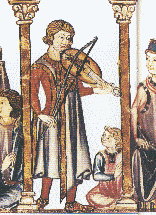Vielle
Someone playing the vielle. Cantigas de Santa Maria, about 1300.
German specialists answer about the origin:
"Was das Bild angeht: es stammt aus einer der Handschriften der Cantigas de Santa Maria. Ich müßte genau nachschlagen aus welcher und wie die genau datiert wird... (entweder spätes 13. Jh. oder frühes 14. Jh. - mit Gerard David (15. Jh.) hat das so überhaupt gar nix zutun). OK, ich habe zwar die Faksimiles von 2 der Hauptcodices, aber nicht vom 3., der am reichsten illuminiert ist (das Faksimile kosten diverse Tausend Euro) - ohne jetzt in die Musikwissenschaft Basel zu gehen und dort den Mikrofilm durchzusehen oder zu schauen ob die das Fakimile haben, könnte ich jetzt nur indirekt erschließen: aufgrund stilistischer Vergleiche, würde ich mit 95%iger Sicherheit sagen: es handelt sich um eine Abbildung aus dem Codex E2, auch Codex T genannt - der hat über 1200 Miniaturen und ist der am reichsten geschmückte der Cantiga Codices. Datiert wird er auf das Ende des 13. Jh.: San Lorenzo de El Escorial, Biblioteca del Real Monasterio, T.I.1 (also known as T.j.1) [e; E²; T]. 256 parchment leaves, 49 × 33 cm. Modern arabic foliation in pencil; songs numbered with illuminated Roman numerals on both leaves, top centre. Layout: normally 2 columns, 44 lines or 11 staves a page; red and blue illuminated capitals; each song headed in red. Illuminations: 1264 magnificent miniatures, normally grouped by 6 (1 full page corresponding to a song) or 12 (2 full pages, singling out the fifth song in each group of 10). Scribes: no detailed study; seemingly uniform French gothic hand. Notation: proto-mensural, based on, but not identical to French pre-Franconian practice (Ferreira, 1987, 1993). Date: ?1280–84 (Ferreira, 1994) Contents: on f.4, after the surviving folios of the index, a fragmentary cantiga without music forms an ‘appendix’; on f.4v the main collection begins, with 194 cantigas (including 3 fragmentary, of which 2 without music, and 1 more with empty staves). This is the first volume of a set of 2; the second, incomplete volume, containing 104 songs with empty staves, is now in Florence, Biblioteca Nazionale Centrale, B.R.20 [F]. Facs.: El ‘Códice Rico’ de las Cantigas de Alfonso el Sabio: Ms. T.I.1 de la Biblioteca de El Escorial (Madrid, 1979)
Also: ich konnte das Bild direkt nicht finden - dazu müßte man das Faksimile durchsehen und nach diesem Ausschnitt suchen - aber stilistisch ist ziemlich eindeutig, daß es eine Cantiga-Abbildung sein muß (und selbst wenn nicht, dann ist es ziemlich eindeutig 13. Jh., bzw. um 1300, keinesfalls 15. Jh.) - ich habe die Art der Abbildung mit anderen aus dem T-Codex verglichen und sie scheint aus diesem oben genannten Codex zu kommen (u.a. habe ich dort in anderen Abbildungen, die ich habe, die Säulenkapitelle wiedergefunden)."|
Dette er en troværdig, fotografisk gengivelse af et originalt todimensionelt kunstværk. Kopier af kunstværket er offentlig ejendom af følgende grund:
Den officielle holdning, som Wikimedia Foundation følger er, at "faithful reproductions of two-dimensional public domain works of art are public domain, and that claims to the contrary represent an assault on the very concept of a public domain". For yderligere oplysninger, se Commons:When to use the PD-Art tag.
Denne fotografiske gengivelse betragtes derfor også som værende offentlig ejendom Vær opmærksom på, at, afhængig af lokale love, kan brug af dette indhold forbydes eller begrænses i dit område. Se Commons:Reuse of PD-Art photographs. | ||||
Yderligere oplysninger om licens til billedet kan findes her. Sidste ændring: Sun, 31 Mar 2024 01:10:57 GMT
